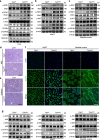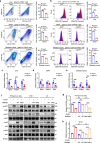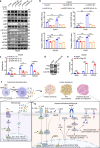Thyrotropin exacerbates insulin resistance by triggering macrophage inflammation in subclinical hypothyroidism
- PMID: 40523992
- PMCID: PMC12229657
- DOI: 10.1038/s12276-025-01478-1
Thyrotropin exacerbates insulin resistance by triggering macrophage inflammation in subclinical hypothyroidism
Abstract
In subclinical hypothyroidism, the levels of serum thyroid-stimulating hormone (TSH) are positively correlated with insulin resistance; however, the precise mechanism is unclear. Except for thyroid follicular epithelial cells, macrophages express the highest levels of TSHR. Thus, we speculate that TSH may promote insulin resistance by triggering macrophage inflammation. Here we established a mouse model of TSH receptor (Tshr) myeloid-specific knockout (TshrMKO) and found that TshrMKO mice showed improvement on high-fat diet-induced obesity and insulin resistance compared with wild-type mice (Tshrf/f). In addition, TshrMKO mice exhibited decreased infiltration and M1 polarization of macrophages in liver, adipose and skeletal muscle. Co-culture experiments proved that Tshr-deficient macrophages decreased gluconeogenesis in hepatocytes but increased glucose uptake in adipocytes and skeletal muscle cells by improving the insulin signaling pathway. Mechanistically, increased TSH levels in subclinical hypothyroidism promoted the secretion of cytokines IL-1α, IL-1β and IL-6 by inducing macrophage M1 polarization, which upregulated EGR1 to transcriptionally activate LCN2 and SOCS3 in insulin target cells, thereby exacerbating insulin resistance. These effects could be reversed by IL-1 and IL-6 blockers IL-1RA and IL-6ST. Thus, we provided mechanistic insights into the predisposition to insulin resistance in subclinical hypothyroidism and revealed the role of TSH in metabolic disorders.
© 2025. The Author(s).
Conflict of interest statement
Competing interests: The authors declare no competing interests. Study approval: Protocols for animal research were approved by the Institutional Animal Ethics Committee of Xi’an Jiaotong University. In compliance with the Declaration of Helsinki, patients were anonymously coded for human experimentation involving specimens. The Institutional Review Board and Human Ethics Committee of the First Affiliated Hospital of Xi’an Jiaotong University authorized the study.
Figures








Similar articles
-
TSH upregulates CYP4B1 through the PI3K/AKT/CREB pathway to promote cardiac hypertrophy.J Endocrinol Invest. 2025 Jun;48(6):1343-1362. doi: 10.1007/s40618-025-02554-z. Epub 2025 Mar 8. J Endocrinol Invest. 2025. PMID: 40056338
-
Perfluorooctanoic acid disrupts thyroid-specific genes expression and regulation via the TSH-TSHR signaling pathway in thyroid cells.Environ Res. 2023 Dec 15;239(Pt 1):117372. doi: 10.1016/j.envres.2023.117372. Epub 2023 Oct 11. Environ Res. 2023. PMID: 37827365
-
Mechanistic Insights into TSH-Mediated Macrophage Mitochondrial Dysfunction via TSHR Signaling in Metabolic Disorders.Free Radic Biol Med. 2025 Jul 19:S0891-5849(25)00843-3. doi: 10.1016/j.freeradbiomed.2025.07.028. Online ahead of print. Free Radic Biol Med. 2025. PMID: 40691908
-
Iodine supplementation for women during the preconception, pregnancy and postpartum period.Cochrane Database Syst Rev. 2017 Mar 5;3(3):CD011761. doi: 10.1002/14651858.CD011761.pub2. Cochrane Database Syst Rev. 2017. PMID: 28260263 Free PMC article.
-
Thyroid Function Within the Normal Range, Subclinical Hypothyroidism, and the Risk of Atrial Fibrillation.Circulation. 2017 Nov 28;136(22):2100-2116. doi: 10.1161/CIRCULATIONAHA.117.028753. Epub 2017 Oct 23. Circulation. 2017. PMID: 29061566 Free PMC article.
References
-
- Biondi, B., Cappola, A. R. & Cooper, D. S. Subclinical hypothyroidism: a review. JAMA322, 153–160 (2019). - PubMed
-
- Vanderpump, M. P. J. et al. The incidence of thyroid disorders in the community: a twenty-year follow-up of the Whickham Survey. Clin. Endocrinol.43, 55–68 (2008). - PubMed
-
- Canaris, G. J., Manowitz, N. R., Mayor, G. & Ridgway, E. C. The Colorado Thyroid Disease Prevalence Study. Arch. Intern. Med.160, 526–534 (2000). - PubMed
-
- Surks, M. I. et al. Subclinical thyroid disease. JAMA291, 228–238 (2004). - PubMed
-
- Cooper, D. S. & Biondi, B. Subclinical thyroid disease. Lancet379, 1142–1154 (2012). - PubMed
MeSH terms
Substances
LinkOut - more resources
Full Text Sources
Medical
Miscellaneous

